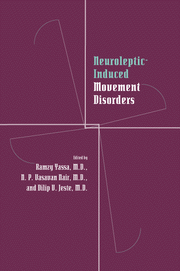Book contents
- Frontmatter
- Contents
- Contributors
- Preface
- Part I Historical perspective
- Part II Clinical aspects of tardive dyskinesia
- Part III Mechanisms underlying tardive dyskinesia
- Part IV Measurement of tardive dyskinesia
- Part V Tardive dyskinesia in different populations
- 19 Cultural aspects of tardive dyskinesia in Asia
- 20 Tardive dyskinesia in North America and the Middle East
- 21 Tardive dyskinesia in Europe
- 22 Role of ethnicity in the development of tardive dyskinesia
- 23 Tardive dyskinesia in children and adolescents
- Part VI Other neuroleptic-induced movement disorders
- Part VII Treatment of tardive dyskinesia
- Index
20 - Tardive dyskinesia in North America and the Middle East
from Part V - Tardive dyskinesia in different populations
Published online by Cambridge University Press: 09 October 2009
- Frontmatter
- Contents
- Contributors
- Preface
- Part I Historical perspective
- Part II Clinical aspects of tardive dyskinesia
- Part III Mechanisms underlying tardive dyskinesia
- Part IV Measurement of tardive dyskinesia
- Part V Tardive dyskinesia in different populations
- 19 Cultural aspects of tardive dyskinesia in Asia
- 20 Tardive dyskinesia in North America and the Middle East
- 21 Tardive dyskinesia in Europe
- 22 Role of ethnicity in the development of tardive dyskinesia
- 23 Tardive dyskinesia in children and adolescents
- Part VI Other neuroleptic-induced movement disorders
- Part VII Treatment of tardive dyskinesia
- Index
Summary
Psychiatry in North Africa and the Middle East, from Morocco to Iraq (excepting Israel), is a burgeoning specialty in an evolving medical field within developing countries. Currently it is beset by two main problems: insufficient numbers of physicians and trained staff and insufficient funding:
Staff. A country like Morocco, with 27 million inhabitants, has no more than 200 psychiatrists, a few dozen clinical psychologists, and about 400 nurses specialized in psychiatry. However, in almost all of these countries, remarkable training efforts are under way and are steadily improving the situation.
Funding. The number of beds available and the budget allocations for psychotropic medications are far behind the actual needs in these countries.
One of the consequences of this inadequate medical provision is that considerable proportions of the patients seen by psychiatrists in North Africa and the Middle East are psychotic, especially those seen in the public sector, for they represent most of the emergency cases. For example, in Casablanca, the second largest city in Africa, more than 80% of the hospitalized patients in psychiatric wards and about 60% of the patients seen in psychiatric outpatient clinics (representing more than 35,000 patients) are psychotic and are treated with neuroleptics. Nevertheless, in North Africa and the Middle East, there have been only a few studies of tardive dyskinesia, one of the most important iatrogenic effects of neuroleptics.
- Type
- Chapter
- Information
- Neuroleptic-induced Movement DisordersA Comprehensive Survey, pp. 267 - 273Publisher: Cambridge University PressPrint publication year: 1996



